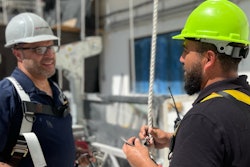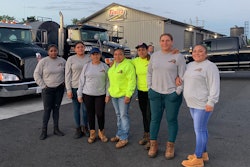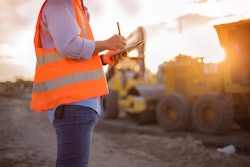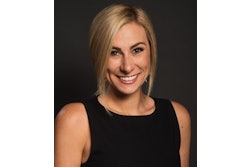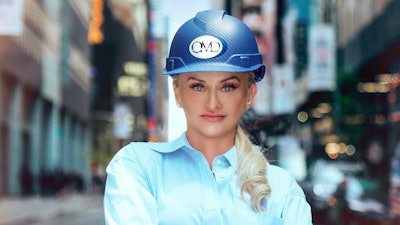
As founder and president of OMD I Corp. (OMD Corp.), Christina Oden has built more than 50 NYC high-end, well-known, and often times celebrity chef-owned restaurants and food and beverage venues. Hiring the best contractors, she can, her company has built hundreds of residential renovations and new constructions. Oden is best known for her involvement in notable buildings like the Brooklyn Chophouse, The Playboy Club, 1Oak, and is among the less than 3% of Woman Founders within the Construction Industry in NYC.
Concrete Contractor connected with her for her unique insight into her success and trends in the construction industry.
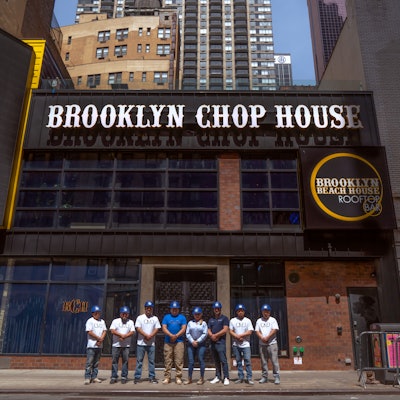 With the 25,000 sq. ft. Brooklyn Chop House project, Christina Oden built custom 2 1/2 in. solid white oak doors with the restaurant logo routered into the panels.OMD I Corp.
With the 25,000 sq. ft. Brooklyn Chop House project, Christina Oden built custom 2 1/2 in. solid white oak doors with the restaurant logo routered into the panels.OMD I Corp.
She eventually bought out her partner, and became the founder and president of OMD Corp.
“At the time, I thought I needed a guy to be taken seriously in this industry in New York City. But I realized quickly on that all you really needed to be is good. New York City doesn't really care what gender you are, as long as you show up and you do the work and you have integrity, and you have the same quality as everybody else. I kind of fooled myself on that. I remember dropping a few rebars in some foundations and I'm sure I probably shoveled a lot and wheelbarrow quite a few tons in my day. I'm more of a ‘I'll hire the best people to do exactly what I need to get done’ instead of me actually being down in the in the mud with them sometimes.
Q. What about the construction industry do you love?
I'm an entrepreneur; I've always been someone to create. So, the aspect of creating something from nothing. In most cases, all you have is a drawing set and a dirt field or you walk into a vanilla box. And now you have to turn in it into this amazing five-star restaurant that's mouth dropping. That is truly exciting. That's what really fuels me and gets me up in the morning. The look that you see on people's face the first time they walk into either a residence or a commercial space that you just finished building when it used to be nothing. Knock on wood, their mouths usually drop open and they're “Wow, what is this!” That that makes it all worth it. That makes the 16-hour days, 7 days a week for 8 or 9 months all worth it.
Q. What does the OMD team do to stay on top of their game and construction?
We self-perform 7 trades, and I generally subcontract my specialties and my MEPSPs. But I usually subcontract to the same teams because we've known each other for so long. I can literally do a walk through and throw a number because I know their numbers like the back of my hand. With that, our in-house team is always doing continued education. We're always taking classes and new courses. We're always going to seminars. We're always going over to the Javits [Convention] Center - they have annexes for all new technology. We go to a lot of seminars and conferences.
We tend to hire on subcontractors that are specialty that can add something new to what we're doing like Venetian plaster, or stucco or gold yielding. What’s become highly sought after is the polished wall concrete slabs - looks like a concrete mural. We did DITA Eyewear back a few years ago, the whole eastern wall of the eye store is these beautiful, polished, concrete slabs with rivets in the corners. It's just beautiful. (Editor’s Note: More on this trend further in this interview.) We're always learning the new techniques. I'm always hiring on subcontractors that can really bring something new to the table.
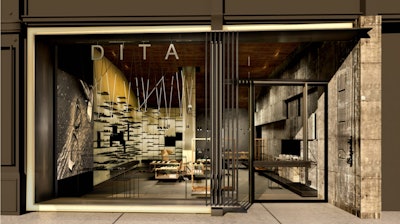 The DITA Eyewear shop is one of many high-end commercial and residential projects Christina Oden's OMD Corp. has taken on over the years.OMD I Corp.
The DITA Eyewear shop is one of many high-end commercial and residential projects Christina Oden's OMD Corp. has taken on over the years.OMD I Corp.
We go to conferences, and we look to see what everyone else has new coming out. A lot of this technology really fascinates me. I feel that it will revolutionize and change the construction industry - especially with the new generation of construction people coming on board. I learned from the old guys. I learned from, the 50, 60, 70-year-olds, and I stayed true to traditional ways of doing construction. But I'm really fascinated with the new stuff, because my younger crew are teaching me a lot of new stuff. They are bringing a lot of nice attributes to the jobsites.
Q. In your experience, what has been one of the most impactful changes in the construction industry from the last five to 10 years?
The last two years we've been in such a such a disarray, I think that everyone has had to really switch gears. They really had to learn to diversify and to learn that this cookie cutter way of doing construction isn't always going to work because the world is upside down. You must think outside of the box and have great relationships with some of your purveyors and get in front of things. I've had to drive to South Carolina and pick up my own lumber.
But what's really been on the cusp of the last couple of years, for me, the thing that I've really been utilizing a lot of is 3d printing. I've utilized that several different times.
Q. Do you mean 3d printing, like the polymer plastic?
Polymer plastic. One specifically, we were building the AKA hotel in Tribeca. We had taken out a wall and there was a pipe in the way. It was just going to be astronomical to reroute it, but the plans called for a bathroom. I was going to erect a wall and the pipe was right in the way. I needed a flushometer to go flush with that wall. But the actual 4x6 carrier inside the wall wasn't close enough to the flushometer that was flush with the with the sheet rock for it to push to eject and cause the water to fill up in the toilet bowl.
I went to a 3d printer and I had them actually manufacture me a longer pointer. I think it was about 8-in. long by about 3-in. tall by about maybe 1-in. thick. It replaced the existing and made the finger probably 5 in. longer. We put it to test, and that thing stood up. Still does to this day. Every time I go to the hotel, I go in there and I push it and it's perfectly fine. I got a little concerned about it being plastic and being printed off a printer, but it was perfect. There was no way for me to have ever been able to facilitate that bathroom if it wasn't for being able to use that 3d printer to add an additional piece.
I'm literally the problem solver. I'm always up under something or inside something or figuring something out and like, “Hey, guys come in for a second. Take a look at this. What do you think.”
We're always like, “Okay, there's got to be a way.” There's always a way. If we put our brains together, there's always a way to figure out the answer. Always, I will never ever give up. That's one big thing about me. I am stubborn, I will never give up. We're going to stay in there. We're going to figure it out. And if that means I'm not going home, I'm not going home.
Q. What construction innovation, like equipment, machine or tool, maybe even a concept do you have your eye on right now? And what kind of problems are they designed to help?
I've been seeing a lot of AI-generated augmented reality. I've been keeping an eye on how I can start to apply it in my daily routine and my daily standard operating procedures of how we do things at my company. The ability to give the client more than a rendering - something more than a pretty picture on a piece of paper. Augmented reality would give the client the ability to step inside of what I'm building out.
For me, I would anticipate that it's going to give me the ability to get in front of a problem before it becomes one - instead of finding out after we've already built out a sizable amount of something. Getting inside of the augmented reality version of it would be able to expedite that without wasting manpower or materials.
Q. I've heard augmented reality gaining traction because of the pandemic itself. A lot of people were forced to work from home. And a lot of them were the drafters using BIM and putting together a building digitally. And that way, they were able to communicate with the team about the changes about what's going on. I'm interested in see how in augmented reality, even virtual reality type of ideas will change the industry because it's coming. It's not going to go away.
Absolutely. You hit the nail right on the head. I'm widely known for my roundtables. They're non-negotiable. Anyone, any client that signs on with me, any architect, engineer, expediter, or designer that signs on for me to build out for them - they know that my Monday morning roundtables are non-negotiable. You must be in attendance; I don't care where you are in the world. Either you need to be in the field, or you need to be on Zoom. We go over the agenda, and we keep very stringent timelines and schedules. Having that ability for the augmented reality is great for me.
Before, people weren't really using computers in that way, especially what I do. I'm in the field every single day, dirty, dusty. I got saw stuff in my hair all day long, so whipping out a computer and saying, “Hey, let's Zoom”, it really wasn't standard for us. But because of the pandemic, bringing the computer into it all is great because now with the augmented reality, we'll be able to get more granular and show things a lot easier.
It's like a nice little segue. I can't exactly say that my old school guys are going to put on a headset and walk around the site, but my newer generation - they're more than open to it.
Q. How is OMD addressing today's labor shortage challenge?
I've been really blessed. I have been really, really blessed. My in-house team, I made sure that I took well care of them during the pandemic, especially in the beginning of it. I refused to lay anybody off. We got creative with initiatives of how to get our jobs.
We were set to have a stellar 2020. We had five jobs, geared up to start the first fiscal of 2020. And then literally, come February, March - all five of them bailed. We had to really switch gears and change it up in different ways to keep working. But I kept them all working. Their loyalty for me and for my company really held true. I kept my 15 to 30 core guys, and I never laid them off - not even from one day. From there, it stemmed. Whenever we would go to a larger job site, we would pull in people that we've worked with worked with before and we were able to fill all our holes pretty quickly.
My subcontractors, they were hit very hard, especially my plumbers. But thankfully, because of my loyalty with them…and of the loyalty that they have for me and my company, they were able to fill my needs quickly. But I know they got hit hard. I would see some new faces on my sites that I hadn't really seen before. What they were doing was promoting that they would do apprenticeships. They were trying to get a lot of the younger generations to come in and start training with them. They were offering the ability to get their licensing through them and being creative with what the perks were. I think that's ultimately how they were able to solve a lot of their staffing issues.
Q. That's pretty clever to say, “Hey, join our team, and we will give you a longer career rather than just a job for the next three months.”
Instead of making someone a laborer, you've given them the ability to stick on and stay around for a career. The payout is you have a more loyal person and you're building something with them. The great thing is that you're not getting someone with bad habits; you get to mold them and teach them from the beginning the right ways to do things.
Q. As we're talking about employment and working in construction, OSHA reports that 9% of U.S. construction workers are actually women. How do you think the trades in the construction industry can appeal to more women?
I hear this a lot. But what I want to always remind “them” is it was less than 1%, a few years ago. We've gone leaps and bounds towards bringing more women and more diversity into the industry, especially here in New York City. I was a part of the naysayers. When I first started, I thought, “There's no way anybody's ever going to take a female owned 100% owned and operated business in the construction industry. Not New York City.” That's what I thought. After six months of doing basically everything myself, I realized that I didn’t really need a guy on my moniker. I just needed to get in there and work and be good at what I'm doing. I needed to learn the trades. I needed to learn and be as good if not better than every man in the room. If I brought that quality…no one ever saw the difference. Maybe they did. But after first couple of conversations, I've never even noticed it. I still get, some people brand new coming to the jobsite walk up to the table or see me in the field and they're like, “Oh, we want to see the boss.” And [the crew] are like, “that's her.” They give me that double take every once in a while, but it takes about 5 seconds where they pretty much realize it doesn't matter because it just really doesn't matter.
 OMD I Corp.
OMD I Corp.
We don't mind knocking one out of the park for you. We just need our opportunity to be at bat. I don't want anyone to ever lower the bar for me - I just want the bar to be fair. You can't expect a company that has no more than 50-100 people to compete and be able to go through an application process [alongside] one of the top developers to match the criteria that they're able to adhere to like their EMR ratings, their sureties’ bonds, those type of things that a smaller company just wouldn't have.
That doesn't mean that we want the big, multimillion dollar jobsite projects but we need to be able to get through the door. We've been working on trying to streamline that process and hopefully we'll be able to see a lot more women and minorities in the industry.
I look at a resume. I'm not looking at gender, because to me, that's insignificant. I need that person to elevate themself and learn the trade as well as, if not better than the man walking in the door. Because, to compete with men, you need to beat men. You need to be able to go toe to toe with them. I do every single day. When I submit a bid a bid to a client, I'm not expecting them to look at my gender. I'm expecting them to look at the meticulousness that I formulated the bid. I want them to look at my previous buildouts. I want them to look at what I offer. I'm not looking at for them to even think for a second about my gender. I want to make sure that if I win that bid, I did it fair and square.
For women in trades, I expect them to do the same exact thing. Learn your trade. Get in there and learn everything there is to learn about that trade. If you're going to be a mill worker, I expect you to do that. If you're going to be in concrete, I expect you to be the best concrete person there is.
Q. What is your prediction for three to five years in the hotel and restaurant restoration segment of the construction industry?
Any movement is good movement for construction. We are we are highly known for high-end bars, restaurants, nightclubs, boutique hotels, and high-end residential because we do all the fine finishes and fixtures. I always said that construction is very geographical. In certain states and certain areas construction is going like wildfire, and I don't see it slowing down. If you take states like Texas and Florida, and Arizona, I think that they're red hot. And then you take areas outside of major metropolitan area, I believe that there there's no slowing down for them either. When it comes to bars, restaurants, nightclubs, and hotels, New York sort of had a mass exodus be due to the lockdown. What I'm seeing now is people coming from other states that always wanted to build a restaurant or always wanted to build a hotel in New York City but never had that opportunity. Either they felt that it was too expensive or there wasn't any inventory- I feel now that there is a good surplus of inventory in the city. I believe people from other states are coming in and buying up as much property as possible.
I'm building six restaurants right now and we've got another nine in the pipeline before the end of 2022. There's no end in sight. I would say that 90% of all my clients are coming from other states [and] it's their first build up for themselves in the city. I foresee that happening for the next couple of years because the inventory got huge. It's starting to get filled up, which is great, and a lot of landlords here have offered a lot of TI money incentives for people to come in and take their spaces.
On the residential side, I believe I found a lot of super high-end residential customers that have come in because they've always wanted to house in New York City, and they felt that they never could find something. Now, the inventory is bountiful [but] I think that's really filling up pretty good.
 The DITA Eyewear shop features a wall of polished concrete panels.OMD I Corp.
The DITA Eyewear shop features a wall of polished concrete panels.OMD I Corp.
Q. What trends have you seen in like decorative concrete work in the high-end finishes?
The polished concrete walls are very, popular - very trendy. I'm seeing them across commercial and residential. In residential, they'll do it as a feature wall: floor to ceiling slabs polished. Sometimes they'll throw a hue in it to pull into different colors throughout the living room or the dining area. I'm seeing a lot of it happen where they're incorporating concrete with waterfalls in the entryways of major palatial residences.
I've seen a lot of color hues be put in the concrete mix like some blues and some grains that are beautiful. Absolutely beautiful. I work a lot with epoxy. They're introducing a little bit of that with the concrete to accent the concrete colors with these different metallic swirls. Absolutely beautiful. I'm not an interior decorator or interior designer by trade or anything but I've been able to see a lot of this stuff coming on trend with the designers that I do work with.
Q. Along your years that you've been in construction, what's the best advice that you've ever received?
Trust, yet verified. It has saved me so many times. I know it's an easy one to say but get it in practice every single day and use it as a tool. When it comes to material deliveries, you must have what you ordered, what arrived, and what's on the invoice. All three must match. Trust that it's there but always verify to make sure the numbers are there.
Trust, yet verify the field. Verify in the field. Don't take anything for granted. That has that has really saved me so many times. I'll look at a drawing and it'll say a quarter to one foot, and you get to the field and you’re like, “Hold on, are we missing five foot? What is this? Let's measure this for ourselves.” So many times, the architect or the engineers go in so fast that by the time I get the bid set out I'm sitting on my draft table, and I'm measuring it out and find out we're missing a wall.
This advice came from one of my first developers I worked for. It wasn't just that he just said it, he demanded it. It became ingrained in my brain to where it’s a daily standard of practice for me.
Q. If you could speak to your younger self, back when you began in construction, what kind of advice would you give yourself?
Believe in yourself. Believe in [your] gut instincts. You must absolutely believe in yourself. You cannot let anybody else put you in a box and tell you what your value is. Do not let anyone tell you where you belong, or what you're geared to do. You forget that path for yourself. You figure it out for yourself. Learn everything there is to learn about the trades. Learn every trade you can possibly get your hands on.
Believe that you can do anything you set your mind to. Don't let anybody ever put you in a box and tell you what your value is. That was the biggest mistake that I made early on. I made it when I started my own company, I didn't believe enough in myself. I didn’t believe enough in New York and in New Yorkers to think that they could accept a woman general contractor. That was a very big mistake because had I believed in myself and believed in the people around me a little bit more, it would have saved me a lot of headache and heartache.
Q. It almost goes back to trust yet verified because you have to trust yourself and then prove to yourself that you can do it and then move forward the next day.
Absolutely. A lot of people are going to try to put you in a box and dismiss you or not see what you see. You must believe in yourself and stick to your guns. Don't let anybody ever tell you what you're valued at. If I didn’t, I would still be back from Kentucky milking cows.
Q. There's nothing wrong with milking cows in Kentucky.
Ain’t nothing wrong with it. I love it. Stripping tobacco, shucking corn, and collecting eggs. I did it all. I'm proud to be from Kentucky. My family still is on the farm, and I got hundreds of little cousins and nieces and nephews there. I'm proud. I tell people all the time: you can take this girl out of Kentucky but you're never going to take Kentucky out of this girl.





